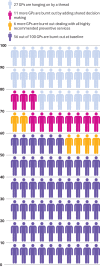Much to do with nothing: microsimulation study on time management in primary care
- PMID: 30545899
- PMCID: PMC6292456
- DOI: 10.1136/bmj.k4983
Much to do with nothing: microsimulation study on time management in primary care
Abstract
Objective: To investigate the credibility of claims that general practitioners lack time for shared decision making and preventive care.
Design: Monte Carlo microsimulation study.
Setting: Primary care, United States.
Participants: Sample of general practitioners (n=1000) representative of annual work hours and patient panel size (n=2000 patients) in the US, derived from the National Health and Nutrition Examination Survey.
Main outcome measures: The primary outcome was the time needed to deliver shared decision making for highly recommended preventive interventions in relation to time available for preventive care-the prevention-time-space-deficit (ie, time-space needed by doctor exceeding the time-space available).
Results: On average, general practitioners have 29 minutes each workday to discuss preventive care services (just over two minutes for each clinic visit) with patients, but they need about 6.1 hours to complete shared decision making for preventive care. 100% of the study sample experienced a prevention-time-space-deficit (mean deficit 5.6 h/day) even given conservative (ie, absurdly wishful) time estimates for shared decision making. However, this time deficit could be easily overcome by reducing personal time and shifting gains to work tasks. For example, general practitioners could reduce the frequency of bathroom breaks to every other day and skip time with older children who don't like them much anyway.
Conclusions: This study confirms a widely held suspicion that general practitioners waste valuable time on "personal care" activities. Primary care overlords, once informed about the extent of this vast reservoir of personal time, can start testing methods to "persuade" general practitioners to reallocate more personal time toward bulging clinical demands.
Published by the BMJ Publishing Group Limited. For permission to use (where not already granted under a licence) please go to http://group.bmj.com/group/rights-licensing/permissions.
Conflict of interest statement
Competing interests: All authors have completed the ICMJE uniform disclosure form at www.icmje.org/coi_disclosure.pdf and declare: no support from any organization for the submitted work; TJC reports a grant from Genentech’s Corporate Giving Scientific Program, outside the submitted work. JFB reports personal fees from Astra Zeneca, outside the submitted work. The authors report no other relationships or activities that could appear to have influenced the submitted work.
Figures



Comment in
-
Lausiges Zeitmanagement bei Hausärzten.MMW Fortschr Med. 2019 Feb;161(3):27. doi: 10.1007/s15006-019-0174-8. MMW Fortschr Med. 2019. PMID: 30778976 German. No abstract available.
References
MeSH terms
LinkOut - more resources
Full Text Sources
